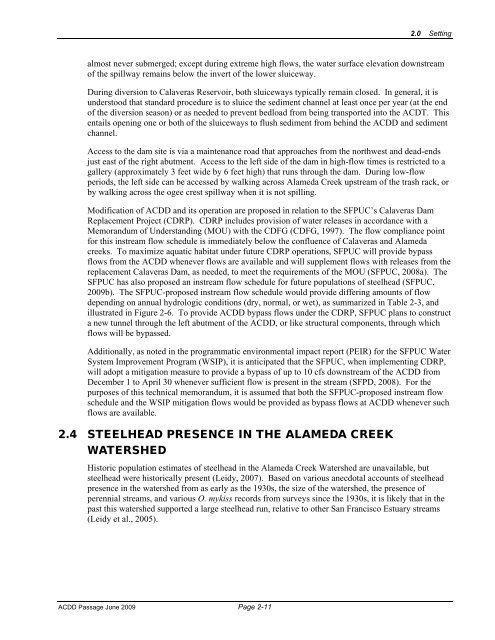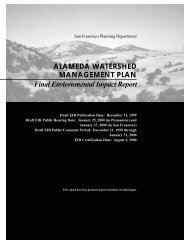Feasibility of Fish Passage at Alameda Creek Diversion Dam
Feasibility of Fish Passage at Alameda Creek Diversion Dam
Feasibility of Fish Passage at Alameda Creek Diversion Dam
Create successful ePaper yourself
Turn your PDF publications into a flip-book with our unique Google optimized e-Paper software.
2.0 Settingalmost never submerged; except during extreme high flows, the w<strong>at</strong>er surface elev<strong>at</strong>ion downstream<strong>of</strong> the spillway remains below the invert <strong>of</strong> the lower sluiceway.During diversion to Calaveras Reservoir, both sluiceways typically remain closed. In general, it isunderstood th<strong>at</strong> standard procedure is to sluice the sediment channel <strong>at</strong> least once per year (<strong>at</strong> the end<strong>of</strong> the diversion season) or as needed to prevent bedload from being transported into the ACDT. Thisentails opening one or both <strong>of</strong> the sluiceways to flush sediment from behind the ACDD and sedimentchannel.Access to the dam site is via a maintenance road th<strong>at</strong> approaches from the northwest and dead-endsjust east <strong>of</strong> the right abutment. Access to the left side <strong>of</strong> the dam in high-flow times is restricted to agallery (approxim<strong>at</strong>ely 3 feet wide by 6 feet high) th<strong>at</strong> runs through the dam. During low-flowperiods, the left side can be accessed by walking across <strong>Alameda</strong> <strong>Creek</strong> upstream <strong>of</strong> the trash rack, orby walking across the ogee crest spillway when it is not spilling.Modific<strong>at</strong>ion <strong>of</strong> ACDD and its oper<strong>at</strong>ion are proposed in rel<strong>at</strong>ion to the SFPUC’s Calaveras <strong>Dam</strong>Replacement Project (CDRP). CDRP includes provision <strong>of</strong> w<strong>at</strong>er releases in accordance with aMemorandum <strong>of</strong> Understanding (MOU) with the CDFG (CDFG, 1997). The flow compliance pointfor this instream flow schedule is immedi<strong>at</strong>ely below the confluence <strong>of</strong> Calaveras and <strong>Alameda</strong>creeks. To maximize aqu<strong>at</strong>ic habit<strong>at</strong> under future CDRP oper<strong>at</strong>ions, SFPUC will provide bypassflows from the ACDD whenever flows are available and will supplement flows with releases from thereplacement Calaveras <strong>Dam</strong>, as needed, to meet the requirements <strong>of</strong> the MOU (SFPUC, 2008a). TheSFPUC has also proposed an instream flow schedule for future popul<strong>at</strong>ions <strong>of</strong> steelhead (SFPUC,2009b). The SFPUC-proposed instream flow schedule would provide differing amounts <strong>of</strong> flowdepending on annual hydrologic conditions (dry, normal, or wet), as summarized in Table 2-3, andillustr<strong>at</strong>ed in Figure 2-6. To provide ACDD bypass flows under the CDRP, SFPUC plans to constructa new tunnel through the left abutment <strong>of</strong> the ACDD, or like structural components, through whichflows will be bypassed.Additionally, as noted in the programm<strong>at</strong>ic environmental impact report (PEIR) for the SFPUC W<strong>at</strong>erSystem Improvement Program (WSIP), it is anticip<strong>at</strong>ed th<strong>at</strong> the SFPUC, when implementing CDRP,will adopt a mitig<strong>at</strong>ion measure to provide a bypass <strong>of</strong> up to 10 cfs downstream <strong>of</strong> the ACDD fromDecember 1 to April 30 whenever sufficient flow is present in the stream (SFPD, 2008). For thepurposes <strong>of</strong> this technical memorandum, it is assumed th<strong>at</strong> both the SFPUC-proposed instream flowschedule and the WSIP mitig<strong>at</strong>ion flows would be provided as bypass flows <strong>at</strong> ACDD whenever suchflows are available.2.4 STEELHEAD PRESENCE IN THE ALAMEDA CREEKWATERSHEDHistoric popul<strong>at</strong>ion estim<strong>at</strong>es <strong>of</strong> steelhead in the <strong>Alameda</strong> <strong>Creek</strong> W<strong>at</strong>ershed are unavailable, butsteelhead were historically present (Leidy, 2007). Based on various anecdotal accounts <strong>of</strong> steelheadpresence in the w<strong>at</strong>ershed from as early as the 1930s, the size <strong>of</strong> the w<strong>at</strong>ershed, the presence <strong>of</strong>perennial streams, and various O. mykiss records from surveys since the 1930s, it is likely th<strong>at</strong> in thepast this w<strong>at</strong>ershed supported a large steelhead run, rel<strong>at</strong>ive to other San Francisco Estuary streams(Leidy et al., 2005).ACDD <strong>Passage</strong> June 2009 Page 2-11








